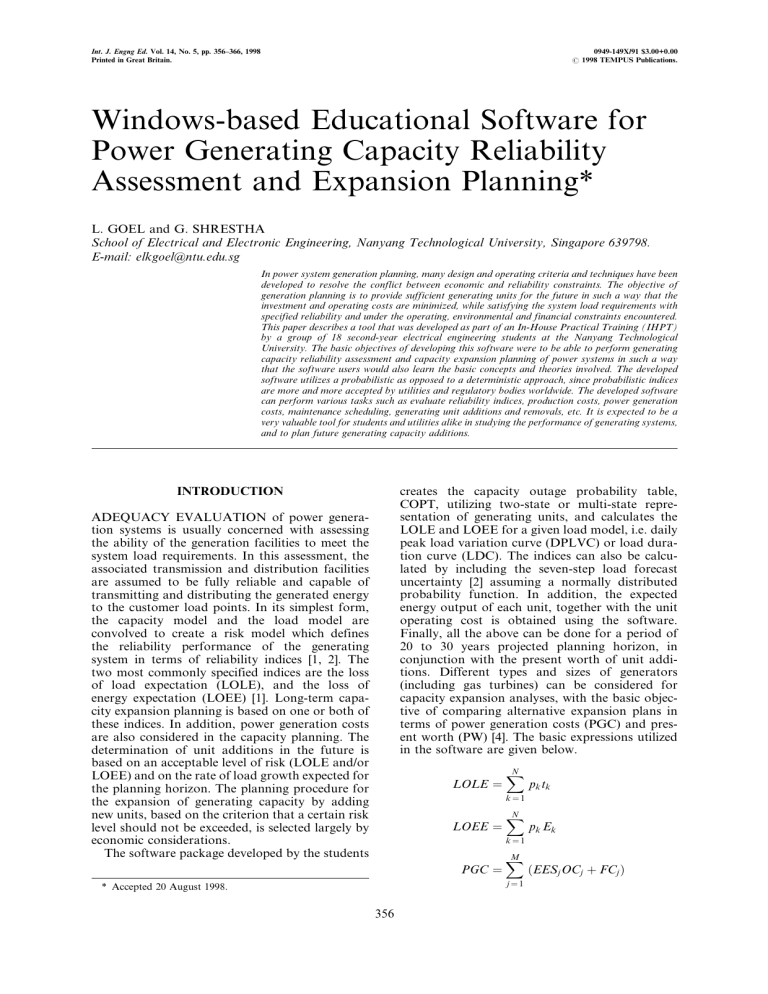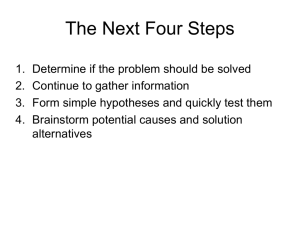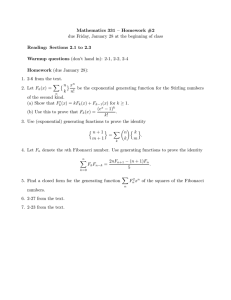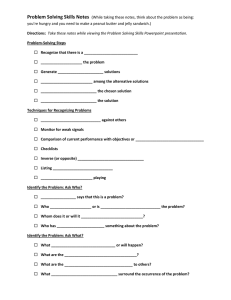Windows-based Educational Software for Power Generating Capacity Reliability Assessment and Expansion Planning*

Int. J. Engng Ed.
Vol. 14, No. 5, pp. 356±366, 1998
Printed in Great Britain.
0949-149X/91 $3.00+0.00
# 1998 TEMPUS Publications.
Windows-based Educational Software for
Power Generating Capacity Reliability
Assessment and Expansion Planning*
L. GOEL and G. SHRESTHA
School of Electrical and Electronic Engineering, Nanyang Technological University, Singapore 639798.
E-mail: elkgoel@ntu.edu.sg
In power system generation planning, many design and operating criteria and techniques have been developed to resolve the conflict between economic and reliability constraints. The objective of generation planning is to provide sufficient generating units for the future in such a way that the investment and operating costs are minimized, while satisfying the system load requirements with specified reliability and under the operating, environmental and financial constraints encountered.
This paper describes a tool that was developed as part of an In-House Practical Training (IHPT) by a group of 18 second-year electrical engineering students at the Nanyang Technological
University. The basic objectives of developing this software were to be able to perform generating capacity reliability assessment and capacity expansion planning of power systems in such a way that the software users would also learn the basic concepts and theories involved. The developed software utilizes a probabilistic as opposed to a deterministic approach, since probabilistic indices are more and more accepted by utilities and regulatory bodies worldwide. The developed software can perform various tasks such as evaluate reliability indices, production costs, power generation costs, maintenance scheduling, generating unit additions and removals, etc. It is expected to be a very valuable tool for students and utilities alike in studying the performance of generating systems, and to plan future generating capacity additions.
INTRODUCTION
ADEQUACY EVALUATION of power generation systems is usually concerned with assessing the ability of the generation facilities to meet the system load requirements. In this assessment, the associated transmission and distribution facilities are assumed to be fully reliable and capable of transmitting and distributing the generated energy to the customer load points. In its simplest form, the capacity model and the load model are convolved to create a risk model which defines the reliability performance of the generating system in terms of reliability indices [1, 2]. The two most commonly specified indices are the loss of load expectation (LOLE), and the loss of energy expectation (LOEE) [1]. Long-term capacity expansion planning is based on one or both of these indices. In addition, power generation costs are also considered in the capacity planning. The determination of unit additions in the future is based on an acceptable level of risk (LOLE and/or
LOEE) and on the rate of load growth expected for the planning horizon. The planning procedure for the expansion of generating capacity by adding new units, based on the criterion that a certain risk level should not be exceeded, is selected largely by economic considerations.
The software package developed by the students
* Accepted 20 August 1998.
356 creates the capacity outage probability table,
COPT, utilizing two-state or multi-state representation of generating units, and calculates the
LOLE and LOEE for a given load model, i.e. daily peak load variation curve (DPLVC) or load duration curve (LDC). The indices can also be calculated by including the seven-step load forecast uncertainty [2] assuming a normally distributed probability function. In addition, the expected energy output of each unit, together with the unit operating cost is obtained using the software.
Finally, all the above can be done for a period of
20 to 30 years projected planning horizon, in conjunction with the present worth of unit additions. Different types and sizes of generators
(including gas turbines) can be considered for capacity expansion analyses, with the basic objective of comparing alternative expansion plans in terms of power generation costs (PGC) and present worth (PW) [4]. The basic expressions utilized in the software are given below.
LOLE
LOEE
PGC
k 1 k 1 j 1 p k t k p k
E k
EES j
OC j
FC j
Windows-based Educational Software for Power Capacity Assessment 357
Fig. 1. Overall skeleton of the menu.
Fig. 2. LDC and DPLVC for the test system.
358 L. Goel and G. Shrestha where: p k t k
Fig. 3. Polynomial approximation of the load model.
individual probability of capacity outage
O k number of time units that an outage O k results in a load loss
N number of capacity outage states in the
E k
EES j
OC j
FC j
COPT
energy curtailed by capacity outage O k
expected energy supplied by unit j
operating cost ($/MWh) of unit j
fixed costs of unit j , and
M number of units in the system.
It can be easily appreciated that manual calculations using the above equations can be quite cumbersome and unwieldy, especially if the capacity planning is to be conducted for a long term such as 15 to 20 years. It is therefore desirable to develop a user-friendly software that can perform the above tasks very efficiently and without losing any accuracy, while at the same time changing any system parameter and studying its impact on the planning indices. The basic objective of this paper is to describe a computer software that has been developed at the Nanyang Technological University's School of Electrical & Electronic Engineering. The software can quantitatively assess the reliability of a power generating facility using one of the many probabilistic techniques available, including load forecast uncertainty. In addition, power generation costs can be evaluated and capacity expansion planning conducted using the developed software. Capacity expansion analysis is based on LOLE and/or LOEE and present worth analysis (PWA). The software was developed to run in the Windows environment using a graphical user interface (GUI). The program is structured in such a way that students and novice users can assimilate the facts and fundamental concepts associated with generating capacity reliability evaluation, before they conduct detailed studies and expansion planning.
It is anticipated that the software tool described in this paper can prove extremely useful to third and final year undergraduate power engineering students, as well as postgraduate students conducting research, and last but not least to utility
Windows-based Educational Software for Power Capacity Assessment 359
Fig. 4. Approximation using LDC.
Fig. 5. Generating capacity reliability module.
360 L. Goel and G. Shrestha engineers and planners who can carry out preliminary studies and make objective, economically justifiable decisions.
USER INTERFACE
Fig. 6. Input generation data sub-module.
An overall skeleton of the menu, which is designed to be very user-friendly, is shown in
Fig. 1. There are three command boxes, namely
Load Model, Generating Capacity Reliability and
Show Indices. When running the software, only the
Introduction and Load Model commands are enabled. Once the user has entered the values of the load model, the generating capacity reliability command is enabled, and once the input for this step is completed the Show Indices command is enabled.
SOFTWARE FEATURES AND
Load model module
There are basically four options to the user to define his/her load model, i.e.,
Option 1Ðuse a predefined `test' system data [3]
(see Fig. 2);
Option 2Ðuse a polynomial up to the fifth order to approximate the load (see Fig. 3);
Option 3Ðuse approximations (where two more sub-options allow the student/user to create different load models, i.e., the load duration curve LDC or the daily peak load variation curve DPLVC);
Option 4Ðinput new load database (LDC or
DPLVC).
For either the LDC or DPLVC sub-options in
Option 3, the student/user can then go on and select various approximations such as a one-line, two-line or three-line approximations, or even a constant load model. A very versatile feature of the
Windows-based Educational Software for Power Capacity Assessment software is its ability to plot the graph once all relevant data have been entered. A software screen display from Option 4 is shown in Fig. 4.
Generating capacity reliability module
The user is expected to provide the input data for the probabilities, capacities, fixed costs and variable operating costs of the various generating units in the system. A sample screen from the software for this session is shown in Fig. 5Ðit can be appreciated very easily that the educational value of such a detailed analysis is tremendous, since all the practical pertinent factors that affect the system reliability are being considered by the developed software. There are six sub-modules of this module, viz., input generation data, COPT (capacity outage probability table), Scheduled Maintenance, Generator Removal, Generating Capacity
Expansion, and last but not least Sensitivity
Studies.
Figures 6 and 7 show the Input Generation Data and the COPT screens respectively, whereas Figs 8 and 9 show the screens from the Maintenance
Scheduling module. The user may select any existing generator and schedule it for preventive maintenance. The maintenance charts utilized are the monthly and yearly ones. This is a very versatile feature of the software since most generators are scheduled for maintenance periodically during their useful lifetimes. Once the maintenance charts are entered and specified, the system reliability can be evaluated.
The generator removal module enables the users to remove any generators from the capacity availableÐthis compliments the Maintenance
Scheduling module in such a way that sometimes generators are removed from service if the system load is off-peak, etc. Once the unit numbers of the generators to be removed are specified, the software will enable the user to re-evaluate the reliability indices.
The objective of generation planning is to provide generating units for the future so that operating and investment costs are minimized while satisfying the load with specified quality and reliability [2, 4]. The determination of unit additions in the future is based on an acceptable level of risk (LOLE and/or LOEE) and on the rate at which load grows across the planning horizon.
The planning procedure for the expansion of generating capacity by adding new units is selected largely by economic considerationsÐthis involves assessing the present values of future investments which in turn depend on interest rates, depreciation, life span of generators, etc. [5]. The necessary background details of performing capacity expansion planning are provided [2, 4]. This paper concentrates more on the developed software and its capabilities and features to enhance its educational value. Figures 10 and 11 show some sample studies using the software.
The sensitivity studies module allows the student to conduct some more studies by changing some pertinent data such as the availability of any generator. The new values of the reliability indices are recalculated and displayed on the screen, as shown in Fig. 12.
Show indices module
This module allows the student to evaluate the reliability indices such as the LOLE, LOEE and the power generation cost. The results may be evaluated using any uncertainty in the load model. The user can select two types of probability distributions, i.e., Gaussian and rectangular to model the uncertainty in the future load. The data required to be entered for the Gaussian distribution is the mean load and the standard deviation associated with the mean value, and the new reliability indices can then be evaluated The basic idea here is to allow as much variation/ uncertainty in the load as possible, so as to be able to arrive at more realistic reliability indices.
EDUCATIONAL OBJECTIVES
361
The developed software is intended to be used by undergraduate electrical engineering students at the final year level, i.e., in the fourth year of the four-year degree programÐparticularly those that take power engineering as their area of specialization. It is being considered at our university as part of a `design' class (details of the design module are provided in [4)] where the power engineering students are required to use the software in order to understand the basics of generating capacity reliability assessment and determine the reliability indices such as loss of load expectation (LOLE) and loss of energy expectation (LOEE). Furthermore, the authors intend to use the software for educating their postgraduate students on the concepts of probabilistic generating capacity planning. It can therefore be easily appreciated that the developed software has versatile teaching and educational uses.
The software can be a useful tool:
.
to introduce the student to the basic concepts of reliability assessment and capacity planning of generating systems;
.
to enable the student to interactively create and utilize different types of load models;
.
to make the student appreciate the effects of various pertinent factors such as unit size, unit forced outage rate (FOR), system peak load, unit variable operating cost, maintenance scheduling, unit addition and removal, load forecast uncertainty, etc.;
.
to enable the student to interpret the results that are presented both graphically as well as in a tabular form;
.
to enable the student to learn the fundamentals of generation planning by going through a guided tutorial first, even before he/she uses the highly user-friendly software.
362 L. Goel and G. Shrestha
Fig. 7. Sample capacity outage probability table (COPT).
Fig. 8. Scheduled maintenance sub-module.
Windows-based Educational Software for Power Capacity Assessment 363
Fig. 9. Scheduled maintenance chart.
Fig. 10. Generating capacity expansion sub-module.
364 L. Goel and G. Shrestha
Fig. 11. Capacity expansion sample results.
Fig. 12. Sensitivity studies sub-module.
Windows-based Educational Software for Power Capacity Assessment
The on-line tutorial was programmed using
VISUAL BASIC 4.0.
365 additions will be implemented in the software in the future.
FUTURE RECOMMENDATIONS
The following improvements are envisaged for the developed software, so that it can cater to more options for system planners and also for educational purposes:
1.
Upgrading to Multimedia Standard.
In order to further enhance the flexibility, capabilities and user-friendliness of the software, it can be upgraded to multimedia standard, i.e., video clips, sounds and graphics can be incorporated.
2.
Homepage on the Internet.
In this modern age of information technology, exchange and transfer of technology is vital to ensure our continuous advancement. Hence, a Homepage on the
Internet would provide an excellent forum for inviting suggestions, downloading of evaluation version, and highlighting any problems arising thereof.
3.
Increasing Computational Speed.
At the present time, evaluating the LOLE, LOEE and COPT requires constant access to various temporary files, which slows down the software run and increases the computational burden. This is one area that needs to be explored further.
4.
Generating Capacity Expansion.
In this project only constant load growth and single type of generator addition over the entire capacity expansion period have been considered. This is clearly a restriction on the practical capacity expansion. It is anticipated that variable load growth and customized type of generation
CONCLUSIONS
This paper describes a Windows-based reliability evaluation software to perform power generating capacity reliability assessment and expansion planning. The developed software enables the evaluation of two fundamental risk indices in generating capacity planning, namely the loss of load expectation (LOLE) and the loss of energy expectation (LOEE). The software was implemented in different modules before being integrated into a single application. The software is highly user-friendly and has many capabilities to create and view load models, to perform various sensitivity studies, to generate and plot graphs, to consider load forecast uncertainty, to include unit maintenance, addition and removal, etc. The software also has an on-line tutorial to guide novice users through the various aspects of data entry and interpretation of results, etc. The indices computation program has been successfully linked with the user graphic interface to provide an appealing software package for power utilities as well as for educational purposes. The software was tested using two reliability test systems, and found to provide results that are very accurate [6].
Acknowledgments ÐThe authors would like to acknowledge the assistance of the following students in developing the software described in the paper: Chang Chi Shan, Chang Chiew Yuen,
Chua Lin Meng, Goh Senglip, Lee Kong Huat, Leong Wai
Mun, Lim Poh Heng, Lim Seng Keong, Loh Khim Huat, Low
Wee Lian, Ng Gaik Joo, Ng Kim Yong, Tan Kok Kwan, Oh
Poh Chin, Rekha, Siak Kah Heng, Sim Chan Kuen, Sim Teng
Kiang, Roland.
REFERENCES
1. R. Billinton and R. N. Allan, Reliability Evaluation of Engineering systems: Concepts and
Techniques , Plenum Press, Second Edition, New York, (1992).
2. R. Billinton and R. N. Allan, Reliability Evaluation of Power Systems , Plenum Press, Second
Edition, (1996).
3. IEEE Committee Report, IEEE Reliability Test System, IEEE Trans.
, PAS-98, (1979) pp. 2047±
2054.
4. L. Goel, T. T. Lie, A. I. Maswood and G. B. Shrestha, Enhancing power engineering education through the use of design modules, IEEE Trans. Power Systems , 11 , (3), Aug 1996, pp. 1131±1138.
5. R. Billinton and L. Goel, A procedure for estimating the worth of generating unit refurbishment,
Canadian Journal of Electrical and Computer Engineering , 15 , 4, Nov 1990, pp. 140±148.
6. School of EEE, In-House Practical Training Report, `Windows-based Software for Generating
Capacity Reliability Evaluation', Group E003, 1996/97, Nanyang Technological University,
Singapore (June 1997).
Lalit Goel was born in New Delhi, India, in 1960. He obtained his B.Tech. Degree in electrical engineering from the Regional Engineering College, Warangal, India in 1983.
Between 1983 and 1988 he worked at various project sites in India for Engineers India
Limited, a premier consultancy organization. He obtained his MSc and PhD degrees in electrical engineering from the University of Saskatchewan, Canada, in 1988 and 1991 respectively. His main research interests are reliability cost/benefit evaluation of electric power systems. He joined the School of EEE at the Nanyang Technological University,
Singapore in 1991 where he is presently a senior lecturer. Dr Goel is a Senior Member of the
IEEE.
366 L. Goel and G. Shrestha
G. B. Shrestha received his BE (Honors) degree in electrical engineering from Jadavpur
University (India) in 1975, MBA from University of Hawaii in 1985, MS in electrical engineering from RPI in 1986, and PhD in electrical engineering from Virginia Tech in
1990. His main area of interest is power system operation and planning. Dr Shrestha is a
Senior Member of the IEEE. Since 1992, he has been with the Nanyang Technological
University in Singapore, where he is presently a Senior Lecturer.







